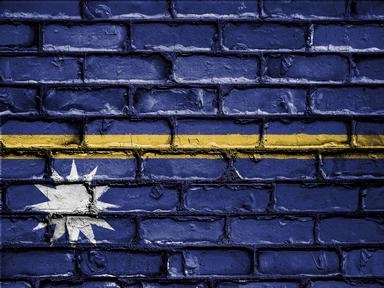Quiz Answer Key and Fun Facts
1. The Republic of Nauru is located in the Pacific Ocean within which island group?
2. Nauru's nearest neighbour is Banaba Island, which is 300 kilometres to the east. To which island nation does Banaba Island belong?
3. Nauru is the smallest (independent) island nation in the world, and only Monaco and Vatican City are smaller independent countries. How small is it?
4. What is the main district of Nauru, containing both the Parliament House and the Nauru International Airport?
5. The flag of Nauru is blue with a thin horizontal gold stripe through the middle. There is also a 12-pointed white star just below the stripe and slightly to the left. What do the 12 points of the star represent?
6. The primary industry of Nauru for many years was the mining of phosphate deposits (from bird guano). These deposits have been nearly completely depleted, and a large percentage of the island's land area was devastated in the process. Approximately what percentage?
7. Nauru's central plateau, holds the location of the island's highest point of elevation at 65 metres. What is the name of this point that was also the site of a Japanese military outpost during World War II?
8. Nauruans celebrate Angam Day (Day of Fulfillment) on October 26th. This is in celebration of the date in 1932 that the population regained what level (following a devastating influenza epidemic in 1920)?
9. From 1888 until 1968, Nauru was under the administrative control of other nations, including the German Empire (1888-1914), Great Britain (1914-1920), Japan (1942-1945), and the combined trusteeship of the United Kingdom, Australia and New Zealand (1920-1942, 1945-1968). With which of these nations does Nauru share a currency (officially adopted in May, 2013)?
10. In its heyday, Nauru had the second highest per capita income in the world, but with the end of its phosphate exports, the country fell on hard times. Thankfully, the Nauruan government developed a tourist industry to bring the standard of living back up to (UN) acceptable levels.
Source: Author
reedy
This quiz was reviewed by FunTrivia editor
Tizzabelle before going online.
Any errors found in FunTrivia content are routinely corrected through our feedback system.
